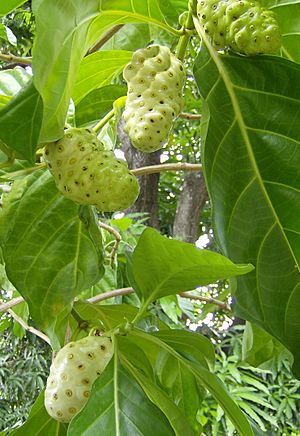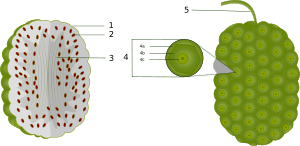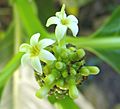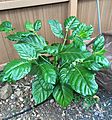Morinda citrifolia facts for kids
Quick facts for kids Morinda citrifolia |
|
|---|---|
 |
|
| Leaves and noni fruit | |
| Scientific classification | |
| Genus: |
Morinda
|
| Species: |
citrifolia
|
The Noni (scientific name: Morinda citrifolia) is a fruit tree that belongs to the coffee family. It originally grew in places like Southeast Asia and Australasia. Ancient Polynesian sailors helped spread it across the Pacific Ocean. Today, you can find noni trees growing in many tropical areas around the world.
This fruit has many different names, but some common English ones are great morinda, Indian mulberry, noni, beach mulberry, and cheese fruit. The fresh fruit has a very strong smell, sometimes compared to vomit. Because of this, it was often used as a famine food (food eaten when other food is scarce) in many places. However, in some cultures, it is still a staple food (a regular part of their diet) and has been used in traditional medicine. You might also see noni sold as a supplement in capsules, skin products, or juices.
Contents
Where the Noni Tree Grows
Noni trees can grow in many different places. You can find them in shady forests, but also on open, rocky, or sandy beaches. A noni tree grows up quickly, reaching maturity in about 18 months. After that, it can produce between 4 and 8 kilograms (about 9 to 18 pounds) of fruit every month, all year long!
This tree is very tough. It can handle salty soils, dry conditions, and even poor soils. This is why it grows in so many different habitats, like volcanic areas, lava-covered coasts, clearings, limestone rocks, and even on atolls (ring-shaped coral islands). The noni tree can grow up to 9 meters (about 30 feet) tall. It has large, simple, dark green, shiny leaves with deep veins.
The noni plant has flowers and fruits all year round. The fruit is a multiple fruit, meaning it forms from many small flowers joining together. When it ripens, it has a very strong smell, which is why it's sometimes called "cheese fruit" or "vomit fruit." The fruit is oval-shaped and grows to be about 10 to 18 centimeters (4 to 7 inches) long. It starts green, then turns yellow, and finally almost white when it's fully ripe. Each fruit contains many seeds.
Noni trees are special because they attract weaver ants. These ants build their nests using the leaves of the tree. In return, the ants help protect the noni plant from some insects that might try to eat it. The strong smell of the fruit also attracts fruit bats, which help spread the noni seeds to new places. There's even a special type of fruit fly, called Drosophila sechellia, that only eats noni fruits!
How People Use Noni
You can find many different noni products today. These include juice drinks, powders made from dried fruits, cosmetic products like lotions and soaps, oil from the seeds, and leaf powders that can be put into capsules or pills.
Noni as Food
Noni is sometimes called a "starvation fruit." This means that people used it as an emergency food when there wasn't much other food available. Even though it has a strong smell and bitter taste, people still ate the fruit during times of famine. In some Pacific Islands, it was even a staple food, eaten either raw or cooked. People in Southeast Asia and Australian Aboriginal communities eat the fruit raw with salt or cook it in curry. The seeds can also be eaten after they are roasted.
In Thai cuisine, the leaves of the noni plant (called bai-yo) are used as a green vegetable. They are the main ingredient in a dish called kaeng bai-yo, which is cooked with coconut milk. The noni fruit (called luk-yo) is also added to some types of somtam (papaya salad).
Noni in Traditional Medicine
In Polynesian cultures, green noni fruit, leaves, and roots were sometimes used as a general health tonic. This was in addition to its use as an emergency food. While people have used noni in traditional medicine for a long time, scientists have not yet found clear proof that it can help human health in specific ways. More research is needed to understand its effects.
Noni for Dyes
Among Austronesian peoples, noni was traditionally used mainly to make dyes. When Austronesian voyagers traveled across the Pacific, they brought noni plants with them as "canoe plants." The bark of the noni tree can produce a brownish-purplish dye that is used for making batik fabric. In Hawaii, a yellowish dye is taken from the roots of the noni tree to color cloth.
Noni's Nutrients
Noni fruit powder contains some carbohydrates and dietary fiber. These are found mostly in the fruit pulp. However, noni juice itself doesn't have many nutrients. The main micronutrients in noni fruit powder include vitamin C, niacin (which is vitamin B3), iron, and potassium. You can also find smaller amounts of Vitamin A, calcium, and sodium.
When you look at noni juice alone, only vitamin C is present in a good amount. For example, 100 grams of noni juice has about 34 milligrams of vitamin C. This is about 64% of the vitamin C found in a raw navel orange. Noni juice also has more sodium than an orange, and a moderate amount of potassium.
The noni fruit also contains many natural chemicals called phytochemicals. These include things like lignans, oligo- and polysaccharides, flavonoids, iridoids, fatty acids, scopoletin, catechin, beta-sitosterol, damnacanthal, and alkaloids. Scientists have studied these substances to see if they have any special effects on the body. However, there isn't enough research yet to say for sure what effects they might have on human health.
Images for kids
See also
 In Spanish: Noni para niños
In Spanish: Noni para niños




